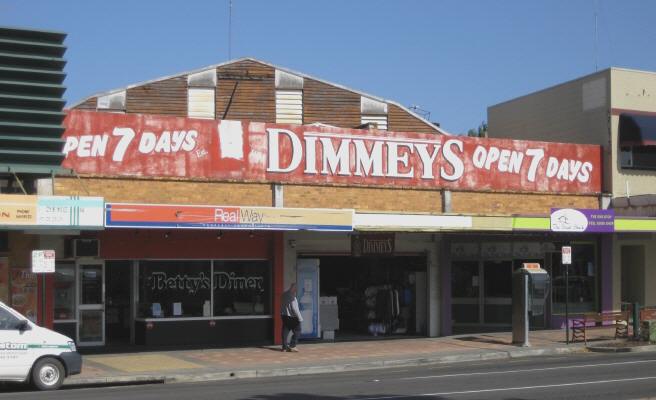
The victory of the Vogue
(The
Vogue Theatre was a cinema that existed on two sites in Currie Street,
Nambour from 1947 to the present day.)
Louis Arthur Eric McCorkell (known as Eric) was born in Chinchilla in 1915. By 1932 the family had moved to Esk, where they set up a general store. In 1932 the store narrowly escaped being burned down in a huge fire that destroyed the nearby Metropole Hotel. By early 1935 commercial activity in Esk (as in most other towns) was having a downturn due to the Depression, and on 25th March of that year, the McCorkells' store had a "huge clearing out sale of the grocery, drapery and hardware lines."
The fortunes of the town suddenly changed for the better when the State Government decided to build a large new dam on the nearby Stanley River, to supply water for the city of Brisbane. Many workers would be needed on this major project, and they would need to settle during the period of construction either in the small workers' camp at the dam site, or in nearby Esk. Work on the Somerset Dam began later in 1935, and a fine new hall was soon erected for the workers' recreation. By then, Mr L. McCorkell had taken over the cinema in the Lyceum Hall at Esk from a W. Andersen. This was Eric's first taste of the cinema world. He thought that he could run a profitable enterprise in the new Somerset Dam hall, screening picture shows for the workmen after their shifts had finished. Accordingly, he presented the first films in the hall to a large audience on 14th August 1936, using a Racycophone projector. Eric also had a talent for still and cine-photography, and was able to shoot, edit and circulate what were called in the industry 'short subjects', or 'shorts'. In 1939 he introduced Technicolor films to the district.
Japan entered World War II in December 1941, and in 1942 work on Somerset Dam was suspended for the duration. Eric enlisted in the Royal Australian Air Force on 26th June 1943 and attained the rank of L.A.C. (Leading Aircraftman) in 20 Squadron. At war's end he was given his discharge on 27th August 1945. He hoped to return to his picture-showing business, but, back in Esk, he found that work on the dam was not going to resume for some time (in fact, it did not restart until 1948, and Somerset Dam was not completed until 1959). Eric looked for another town where he could set up a cinema.
Meanwhile, in Nambour, by September 1945 the Savoy Cinema in the Maroochy Shire Hall auditorium had been operating successfully for a little over four years. Peace had finally returned to the world, and on the 25th of that month, the Maroochy Shire Council received a letter from a person identified as "S. A. McCorkell of Esk", applying for a licence to screen pictures at Nambour. This letter was written within four weeks of Eric's leaving the Air Force. The applicant said that if the licence were granted, it was the intention to erect a modern theatre and plant. This would be the first purpose-built cinema to appear in Nambour, all of its predecessors being general-purpose halls where the screening of motion pictures took place along with other public functions. The Council held over any decision on this for a month, to allow the Savoy Picture Company time to provide a response to this unexpected competition. {28-9-1945, p.1}
The Savoy requested that the Council provide protection for their present licencee (themselves), but went further. They said that if the Council wished it, they would vacate the Town Hall on the condition that any agreement they had with the Council be terminated without penalty, and that they, too, would request permission to build a modern theatre. At its October meeting, the Council decided to approve Mr McCorkell's application and grant him permission to build his theatre, subject to certain conditions which included the submission of detailed plans of the 'modern theatre' and its furnishings, and also the proposed site. {26-10-1945, p.6}
Within seven weeks, Mr Christy Freeleagus presented plans to demolish the Diggers' Hall and build a new Savoy Cinema on the site. His architect's drawing appeared in the Nambour Chronicle just before Christmas, 1945: {14-12-1945, p.7}

Image courtesy Sunshine Coast Libraries
Further expansion is planned for Nambour. The latest is the proposed new Savoy Theatre to be erected shortly for Mr Christy Freeleagus. In planning the theatre both externally and internally, a functional motif has been adopted. The exterior, simply treated, relies for its effect on good massing and proportions with a large, central neon sign. Above the awning, the building will be faced with cream face bricks with ornamental features over the side windows. The awning will be equipped with the latest illuminated sign. One shop is provided to the street frontage besides the entrance foyer, which will have ticket box and manager's office and plate glass doors. The foyer will have a terrazzo floor in ornamental design. The lounge will continue the foyer treatment and will be carpeted throughout, and furnished with settees and lounge chairs. Ladies' and gentlemen's toilets open off the lounge, and these have been unobtrusively placed and screened from the lounge.
The auditorium has been designed as a modified stadium type, and seats approximately 1000 persons in all, slightly more than half this number being accommodated in the gallery and royal lounge. The treatment of the auditorium will be modern, with vertically fluted wall panels breaking up the plain surfaces, and the walls are to be artistically painted in an all-over modern pattern in attractive colours. The proscenium arch has received special treatment, and three deeply recessed niches will be fitted with hidden reflecting lights forming an attractive, striking and ornamental feature on each side of the screen. The ceiling of the auditorium will be carried out in fibrous plaster in a simple but effective panelled treatment, the vertical wall panels being carried across the ceiling. Acoustically, great care has been given to the general design, as it is essential that good sound be provided. Lighting of the main auditorium will be carried out by pendant light fittings of massive yet elegant design. A small stage has been provided and drapes and curtains, etc., masking the screen, will aesthetically complete the appearance of this modern and artistic auditorium.
High class modern seating is to be provided throughout the theatre with lounge chairs in the lounge proper. It is also proposed to instal aisle lighting, and a number of seats will be fitted with aids for deafness, if same are required. Generally, the building will be constructed of brickwork with wood floors, steel roof trusses and asbestos cement roofing. Ample escape doors have been provided, and ventilation of the auditorium has been taken care of by a number of Naco panels along each side. {14-12-1945, p.7}
This was the second time the Savoy Company had announced plans to build an up-to-date cinema in Nambour.
As 1946 began, the local newspaper reported that the Shire Council had examined the plans for the two new picture theatres proposed by the Savoy Picture Company and Mr McCorkell. In each case the plans were regarded as satisfactory, except for certain alterations needing to be made. The plans were returned to the applicants so that the alterations could be effected. By February, Mr McCorkell had changed his position somewhat, and now wanted to construct his cinema in two stages. He would expend ₤500 on a first section, to be completed by 30th June 1946. This first section would be the walls and the floor, and the second section, also costing ₤500 would commence on 1st July. The first section would become part of the permanent structure. This procedure would be used to circumvent war-time regulations which limited the amount that private individuals could spend each financial year in building projects. These regulations had not yet been rescinded, and the Shire Council granted Mr McCorkell permission to follow this course of action. {25-1-1946, p.3} {1-3-1946, p.1}
This perceived favourable treatment that Mr McCorkell received, generated an anonymous letter to the editor of the Nambour Chronicle:
Sir, Please allow me space in your valuable paper to criticise the inconsistency of the Maroochy Shire Council. At the February meeting, an application was granted permission (subject to the legal aspects being satisfactory) to erect a picture theatre in Nambour piece by piece, namely that ₤500 be spent this financial year and ₤500 the next financial year, so that the State legislation controlling buildings will not have been infringed. The applicant in his letter, told the Council that he had sufficient materials to carry out his project, and also a contractor waiting to go on as well. Now, sir, there is already a picture show at Nambour which pays the same Council ₤500 per annum for the use of its theatre, and screens pictures every night at prices within the reach of all pockets. This is sufficient for the town's needs for years to come.
It seems a peculiarity that one man can secure materials for something that isn't urgently needed (at present at any rate), and yet at the same [Council] meeting, the inspector in charge of building by-laws reported that though many people had secured priorities from the Government for houses, they could not buy materials for same. There were also pathetic letters from others who have just started farming, asking permission to live in tents until such time as they can secure homes. Surely the Council's actions need a searching investigation, so that whatever materials for house-building can be diverted to those who rightly should have them. Thanking you, yours etc., JUSTICE. {1-3-1946, p.5}
The following week's issue carried a reply:
Sir, Permit me space in your paper to reply to "Justice". The criticism of the Maroochy Shire Council is most unjust. I am concerned with the treatment meted out to the picture-going public of Nambour at the hands of the [Savoy] Picture Company, which complains that it is required to pay ₤500 per year as rental for the Town Hall and is required to screen pictures every night. I would submit that the screening of pictures every night is for the benefit of the Company's profit-and-loss account, rather than a desire to fulfil a public necessity.
Mention was made in "Justice's" letter about the price of admission suiting the pockets of everyone. I wonder if "Justice" is sincere in that statement. I imagine that the prices of admission charged by the Picture Company are the maximum allowed by the Price Fixing Commissioner. If the public were being considered, I don't think any objection would have been raised if the prices had been reduced below the maximum. Might I ask "Justice" to answer these pertinent questions:
Were second-hand chairs transported from Sydney for use in the theatre at a time when all transport facilities were urgently required for the soldiers at war?
Are the prices of admission charged by the Company the maximum allowed by law?
Did the Picture Company charge the soldiers who were camped in this area during the war full price, when every other organisation in the country was doing its best to entertain the soldiers at an expense commensurate with their pay?
Was the Returned Soldiers' League - acting under Federal Government request - charged ₤10 as rental for the screening of Sons of Anzac when the two Maroochydore theatres screened the picture without cost, and supplied all staff labour free?
Did the Picture Company refuse to grant picture benefits to the Nambour Patriotic Committee and the Nambour branch of the Red Cross during the war?
Did the Picture Company refuse to grant the Returned Soldiers' League the use of the Diggers' Hall to hold a Victory Ball on the night of 26th April next, the date originally intended, and force it to hold the Ball on the night of 11th April, a date which apparently suited the convenience of the company?
Were permits obtained for the fourteen sheets of plain iron and the timber used in the erection of the Company's sign in Currie Street?
Did the Company originally intend to allow the Diggers' Hall to be used for the staging of the Nambour Men's Concert and, if so, what caused a change to be made?
It is my opinion that the need for asking of the above eight questions shows conclusively that the Council's actions in granting a permit to an ex-serviceman to erect another picture show in Nambour is well merited and will give the public of Nambour an opportunity of supporting him in his effort at rehabilitation. I await with interest the answers to the questions set out in my letter. Yours etc., TRUTH. {8-3-1946, p.5}
The editor stated that further letters on this subject and bearing a similarity were not published. This second letter produced a reply, but this time the writer did not hide behind the cloak of anonymity:
Sir, This Company regrets that your contributor to your last issue of The Chronicle, who assumed the name of "Truth", did not write in accordance with his chosen name in suggesting an untruth, namely, that the Company charged full rate to soldiers with the A.I.F. when they were here. We produce for your inspection a letter from 3rd Aust. Division Headquarters, dated 18th Nov. 1942, reading as follows and signed by Lieut.-Col. Tomkins:
'Your letter of 13th Nov. 1942 is acknowledged and your offer as outlined in Para. 3 of your memo is accepted. The reduction in price is appreciated.'
This speaks for itself. Your correspondent refers to a Returned Serviceman. An inspection of the Esk Electoral Roll shows that the only S. A. McCorkell appearing is a woman. The application to the Council is by one S. A. McCorkell [of Esk]. My Company does not want to argue its cause in the public press or give a lengthy reply to all the points in the letter referred to. The reliability of the whole may well be judged by the above. Yours, etc., NAMBOUR SAVOY PICTURES PTY. LTD. - Christy Freeleagus, Chairman of Directors. {15-3-1946, p.5}
By September of 1946, Eric McCorkell and his wife Sarah Alexandra (known as Lex, the 'S. A. McCorkell' of the first letter) had moved from Esk to Nambour. As an ex-Serviceman, he promptly joined the local Sub-Branch of the R.S.S.A.I.L.A. The other Diggers rallied behind him in his attempt to set up a picture theatre in opposition to the Savoy, which still operated out of the Maroochy Shire Hall. Mr McCorkell applied to the Council for entertainment and picture-showing licences and they had no objection. He also had unanimous support from the Nambour Chamber of Commerce. Although he had the Council's permission to screen pictures, the Picture Theatres and Films Commission refused to issue the necessary government licence. {6-9-1946, p.2} {15-8-1947, p.10} {17-4-1959, p.6}
Nevertheless, Mr McCorkell began construction of his theatre on the understanding that, for the time being, it would be used for live entertainment only, and not for use as a cinema. It was located on the western side of Currie Street, between Mitchell and Bury Streets, and opposite the Maud Street intersection. Completed in August 1947, the theatre was called the 'Vogue'. The Sunshine Coast Regional Council's Fred Murray building stands on the site today. {15-8-1947, p.10}
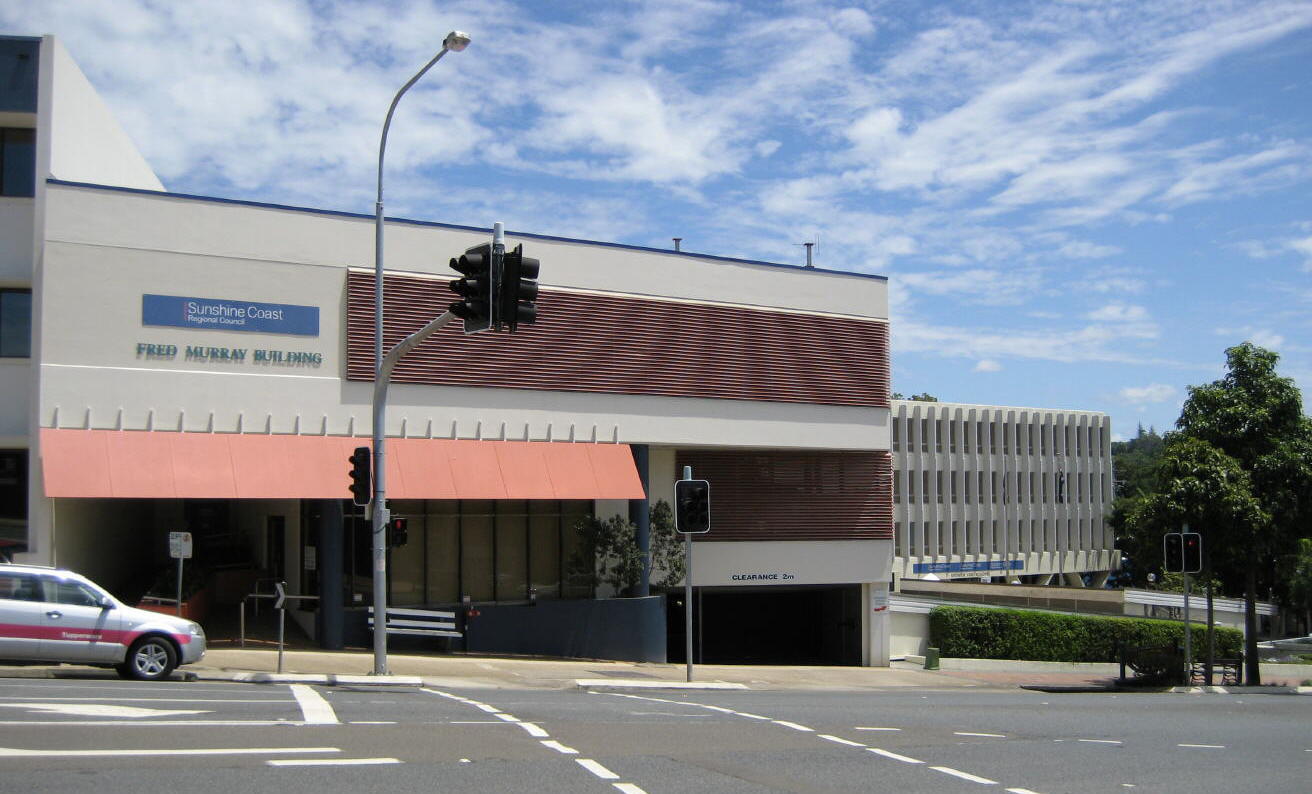
The site of the first Vogue Theatre as it appears in 2009.
The Nambour Chronicle was invited to attend the sound and lighting tests at the new theatre, and described their visit so:
SOUND AND LIGHT TESTS AT THE VOGUE
New Theatre Revelation at Nambour
Stepping into The Vogue Theatre from Currie Street, one is amazed at what has been accomplished by initiative, courage, and utilising the almost-discarded to bring about an interior appearance which bespeaks comfort, convenience and restfulness. It is as near a modern theatre as the limited expense by regulation could possibly conceive. And it is all the grit, enterprise and vision of Mr E. McCorkell, the proprietor.
Yesterday the sound and light test was in operation when a Chronicle representative entered the precincts. The effect was most pleasing and shows ingenuity in the manner in which materials have been converted to suit the circumstances. Here is a restful theatre, the main floor of which is 90 feet by 46 feet, with a stage of 30 feet by 10 feet. The floor, which has been specially treated with a bitumen surface penetration, dips four feet from the entrance to the foot of the stage.
At the entrance there is a room on either side, one known as the 'crying room'. It is a convenience where mothers can convey crying children from the main theatre, and while attending them can view the screen, and where also a speaker is installed. The other side is a well-equipped office, and the 'camouflaging' to make the old new has been effected here as well as in all other parts of the building.
Seating is the recognised theatre lounge chairs, and in the small section in the front rows the ever-rest canvas chairs. The traffic-ways throughout the theatre are covered with a bitumenistic surface matting. Seating accommodates 600, and with the two projectors, sound effects and all arc lighting, the cost is ₤4000. Interhouse telephones extend to all parts of the theatre, and from the operating box, which is set apart on another elevation, the electric switches control the movements of the screen curtain, as well as for other purposes. One of the outstanding achievements is that 90 per cent of the covering material is black iron, but to view the interior this would be unrecognisable, so skilfully and effectively has the work been carried out.
Red, white and green lights cast a soft sheen to the curtain, and at the sides of the building is red and white concealed lighting. Ceiling ventilation is also most effective, and construction for this adds to the design of the theatre. Until such times as the ultimate plans of the really modern theatre become a practicability, this set-up will suffice, but as a further asset to its appearance, lawns and gardens will beautify the entrance. The whole of the electrical installation, which is almost completed, was carried out by Mr W. A. Donald, Nambour. {29-8-1947, p.7}
The Shire Council had approved the Vogue for use as a live entertainment venue, so within a week, the theatre presented its first performance, a 'Scotch Concert', led by the Scottish Pipe Band and singers. By 27th September, the live entertainment Stage Show was held, in which a number of artists appeared, all of whom had been heard on one of the most popular radio shows of the time, Australia's Amateur Hour with compιre Dick Fair. The two cinema projectors, which were reported above as having been installed, could not be used until the Picture Theatres and Films Commission granted Mr McCorkell a licence to screen motion pictures. {12-9-1947, p.2} {26-9-1947, p.5,6}
Nambour folk immediately adopted the Vogue as the best venue in town for live shows and entertainment, and it became popularly known as the 'tin shed'. Facilities for the performers and actors were not much better than those provided at the Diggers' Hall, as no dressing rooms were provided at either facility for people to change costumes and be made-up. At both venues, men's and women's changing and dressing tents had to be erected in the yards behind each theatre when needed. Fifteen years later, Mrs W. F. Newnham recalled performing one-act plays at the Vogue, as a member of the Nambour Amateur Theatrical Society (N.A.T.S.). She said, "There was very little room in the wings of the stage, so we had to wait at the bottom of a set of very steep and rather dangerous steps. When the cue was given to go on stage, we had to scramble up these steps, with the aid of a few members pushing and pulling to get us there on time." {11-6-1965, p.2} {15-10-1965, p.26}
Here is a selection of functions and entertainments that were put on in the Vogue Theatre from late 1947 until the end of 1948:
Grand Concert {14-11-1947, p.4}, St. Andrew's Day Celebration Concert {14-11-1947, p.4}, North Coast and Stanley River District Christian Endeavour Union United Rally {23-1-1948, p.4}, Nambour and District War Memorial Committee Public Meeting {6-2-1948, p.4}, Nambour Eisteddfod {27-2-1948, p.4}, Nambour Christian Endeavour Easter Convention {25-3-1948, p.4}, R.S.S.A.I.L.A. May Day Concert {30-4-1948, p.4}, North Coast Caledonian Society and Show Committee Amateur Trials (an evening something like a cross between Dick Fair's Amateur Hour and Bob Dyer's radio show, Can You Take It?, run as a series of events held every fortnight) {14-5-1948, p.10}, Nambour Volunteer Fire Brigade Concert {14-5-1948, p.4}, Nambour Amateur Theatrical Society (N.A.T.S.) Variety Show {14-5-1948, p.4}, Band Concert with the Brisbane Federal and Maroochy District Brass Bands {11-6-1948, p.1}, North Coast Show Society Variety Concert {2-7-1948, p.4}, a Recital by Paul Schramm (Viennese classical pianist) {23-7-1948, p.4}, Amateur Boxing {27-8-1948, p.4}, North Coast Caledonian Society and Show Committee Amateur Trials Grand Final Night (the final was broadcast from the Vogue on radio 4GY Gympie) {1-10-1948, p.7}, a Music Recital {29-10-1948, p.4}, N.A.T.S. Orchestral Concert {12-11-1948, p.4}, a Grand Dance Display {12-11-1948, p.4}, and Monster Amateur Boxing Contests {19-11-1948, p.8}.
The Nambour public once again began to clamour for a second cinema venue in the town, so that they would have some choice of programs to attend, and offered their support for having a cinema at the Vogue. A weekly columnist in the Nambour Chronicle wrote in the Christmas 1947 issue:
The Vogue picture theatre question came up for serious discussion at the Nambour Sub-Branch of the R.S.L. Ex-soldiers have not made any hurried move in this matter, but after detailed investigation of every angle, they have taken up the fight with the determination that has won the day in many more difficult battles. They are now determined that, in accordance with public demand, pictures will be shown in the Vogue Theatre.
What appears to be a starving out process is taking place because of the action of the controlling body [Picture Theatres and Films Commission] in repeatedly deferring a decision re permits [licences]. This may react in the public, led by the R.S.L. Sub-Branch, giving up their picture relaxation in disgust. The R.S.L. is determined now that ex-Digger McCorkell will not be denied his just dues by any set of circumstances that is not in line with British fair play. {24-12-1947, p.6}
This issue generated letters to the editor in the local paper, but to no effect, as on Christmas Eve Mr McCorkell received a letter saying that his application to show pictures at the Vogue was refused. The Picture Theatres and Films Commission stated that one licence was all that Nambour needed, and that licence was held by the Savoy Company. {12-12-1947, p.5} {19-12-1947, p.1} {2-1-1948, p.2,3}
Immediately this decision became known, the R.S.S.A.I.L.A.'s Nambour Sub-Branch convened a public protest meeting on 7th January 1948 at the Vogue Theatre - where else? They also referred the matter to the Minister of Public Works, and took steps in Nambour to have the matter reconsidered. {2-1-1948, p.4,6,8}
The Nambour Chronicle reported on the public meeting in their next issue:
Nambour has never previously known the attendance at a public meeting that created a record of over 500 persons in the Vogue Theatre on Wednesday evening, when unanimous acclamation was given the second picture licence for the town. This was indicated by numerously-signed petitions, a deputation arranged and protests voiced. The desire is for a reversal of the decision by the Films Commission.
The meeting was attended by Maroochy Shire Councillors led by Chairman Mr Andrew Thompson, ex-Diggers, citizens, representatives from the Nambour Chamber of Commerce and Industry and the Nambour and Mapleton Progress Associations, and the State Member Mr D. A. Low M.L.A. Letters of support for Mr McCorkell came from other Sub-Branches of the R.S.S.A.I.L.A., including the one at Esk.
Resolutions unanimously and applaudingly assented to were:
1. That the citizens of Nambour and district are in need of a second picture theatre in Nambour, in order to accommodate the existing and growing population of the localities, and to promote competition and progress of the town.
2. That this meeting of citizens of Nambour and district appoint a deputation to wait upon the State Premier placing before him the above resolutions, and requesting that the decision made by the Films Commission be rescinded, and a picture licence be granted to Mr E. McCorkell of Nambour.
3. That the signatures of the citizens of Nambour and district present, be presented to the State Premier by the deputation as a record of indignation of the recent decision of the Films Commission in refusing a second picture licence in Nambour to Mr E. McCorkell of the Vogue Theatre, Nambour, an ex-serviceman of World War II.
4. That Cabinet be requested to reconsider the decision in refusing Mr McCorkell's licence in view of additional evidence which can now be sub-mitted by the Nambour Sub-Branch. {9-1-1948, p.1}
If the people at the meeting thought that their protests would have a positive result, they were mistaken. The Government's response was 'official silence', or what was called by bureaucrats of the time, 'masterful inactivity'. The Minister in charge of the Films Commission said that he did not have the power to annul or change the Commission's decisions. In March, the Film Commissioners made a slight concession on Mr McCorkell's behalf. They said that if he made a third application for a licence, then the Commissioners would hold public sittings in Nambour so that all interested parties could put their cases. {20-2-1948, p.1} {12-3-1948, p.3,5}
Townsfolk laid much of the blame for Mr McCorkell's woes at the door of the Savoy Company, which all along had striven to convince the Film Commission that Nambour was too small a town to be profitable for two cinemas. The people knew that Maroochydore's 'Star' and 'Beach' theatres were still operating successfully after many years, and at the time Maroochydore was a coastal town smaller than Nambour. (In reality, the 'Star' and 'Beach' picture theatres very often ran identical programs between 1941 and 1955, these being shown as such in over 400 advertisements in the Nambour Chronicle during that period. In the three years 1947 - 49, there were 108 instances of the two cinemas running the same pictures, about 70% of the programming. The choice for cinema-goers in Maroochydore was really no better than at Nambour, in that for most of the time, only the venue was an option, not the films being screened.) {15-8-1947, p.10} {24-12-1948, p.10}
The Savoy Company therefore decided to publicly outline their position at a meeting in their Diggers' Hall on Monday, 22nd March 1948. The Nambour Chronicle reported on this meeting:
Fifty persons representative of public organisations attended a meeting convened by the Savoy Pictures Pty. Ltd. in the Diggers' Hall on Monday evening to hear the point of view of the Company on the second picture licence application outlined by Mr C. Freeleagus (chairman of directors). Mr Freeleagus traversed the activities of the Company and the difficulties which beset the picture business generally, and the accompanying rising costs to maintain a high standard of entertainment in Nambour. He was supported by two representatives of the Motion Pictures Exhibitors' Association.
Moving a vote of thanks to the speakers, the Secretary of the Motion Pictures Exhibitors' Association, Mr Caldwell, said that the whole matter of the granting of the second picture licence for Nambour was one entirely for the Films Commission to decide, and the application would be dealt with from the viewpoint of whether the second licence at Nambour was really warranted. {25-3-1948, p.1}
Apparently, an allegation was made at the above meeting that Mr McCorkell (who had spent ₤6000 on the Vogue so far) was being backed by two American film companies. Though he had approached Metro-Goldwyn-Mayer regarding screening of their films (which one citizen claimed that the Savoy did not show), this hardly amounted to financial backing. {2-1-1948, p.2} {9-1-1948, p.5} {2-4-1948, p.7}
On 2nd April, 1948, the manager of the Savoy Theatre Mr R. Kelleway advertised his Vauxhall car for sale. Maybe this was an omen, for by the end of the month his Savoy Theatre was gone, as well. {2-4-1948, p.5}
The Maroochy Shire Hall in the 1930s. Painted car-parking spaces in the
centre of Currie Street indicate that the road surface has been bitumenised,
dating the photograph as later than January 1935. The arched roof of the cinema attached to
the rear of the building can be seen to the right of the main faηade.
Photograph courtesy Sunshine Coast Libraries
SAVOY PICTURE THEATRE DESTROYED IN MAROOCHY SHIRE HALL FIRE
Sunday, 25th April 1948 was Anzac Day. In Nambour, the usual parade assembled outside the Diggers' Hall, and at 10.10 am the marchers moved off, led by the Maroochy Town Band. They turned right from Howard Street into Currie Street, and proceeded past the Maroochy Shire Hall and Station Square, down the hill and over the Petrie Creek bridge to the Cenotaph [a white obelisk in Coronation Avenue], where floral tributes were laid. About 400 people were in attendance. After a short address, the parade marched back to Station Square where they were dismissed. The intention was that everyone would re-assemble there at 8.30 pm that night, for a public memorial service in the Shire Hall auditorium, the singing of hymns being accompanied by the Town Band. Sadly, this part of the Anzac Day commemoration was not to be held as advertised. {16-4-1948, p.3} {30-4-1948, p.8}
With the alarm of "Fire!" being given from a neighbouring house at about 2 pm that afternoon, the townspeople rushed to the scene of the outbreak, the Maroochy Shire Hall. Smoke was seen to be issuing from the auditorium behind the main portion of this building, which housed the Savoy Picture Theatre. The Volunteer Fire Brigades from Nambour, Yandina, Eumundi, Maroochydore and even Gympie came as quickly as they could, but even the Nambour Brigade took half an hour to get to the fire and run out their hoses.
[By 1948, the local Volunteer Fire Brigades had progressed to the point where they had their own vehicles, which in Nambour's case was a twelve-year old Ford utility with a small trailer. These were equipped with ladders, hoses, pumps, hatchets and water tanks, more or less. Nambour did not receive a reticulated water supply until 1959, so in 1948 there were no fire hydrants available. Instead, hoses had to be run out to the nearest available water, which in this case happened to be Petrie Creek, a few hundred yards away, but reachable if a number of the large, canvas hoses were joined together. The vehicles and equipment were kept in a brigade shed - the first Nambour Fire Station with a real 'fire-engine' did not appear until 1956.]
Problems occurred with the hoses developing leaks, and various sections had to be swapped while the pumps maintained pressure. The water level in Petrie Creek was low at the time, and the powerful pumps, capable of delivering 500 gallons per minute, sucked up mud as well as water, which threatened to damage them. Two men, Edgar Plater and James Bell, waded into the creek up to their waists, and held the inlets of the hoses up and away from the mud for the duration of the fire, thus ensuring a good supply of water for the men on the other end of the hoses. The firemen did their best, but the roof of the auditorium soon collapsed and the Savoy Theatre was destroyed. The floor continued to burn, being covered by roofing iron which protected the flames from the water being poured in. The iron was dragged away where possible, but it soon became apparent that the most important task was to protect the remainder of the Maroochy Shire Hall, namely the Council offices, rented offices, and the shops at the street frontages. {30-4-1948, p.1}
Although the offices of solicitors Bentley and Shrapnel and the three shops on the railway side of the main entrance were severely damaged, brave work by the firemen saved the rest of the building, including the imposing street fronts. Many Council record books were burned or ruined by water, and the main Council office and meeting room suffered from water damage, as did the remaining shops. The masonry building itself was not severely injured, except for the lost auditorium and the wooden walls between the cinema and the rest of the building. Soon the Maroochy Shire Hall was repaired, but the auditorium was not rebuilt until 1960, the site of the erstwhile Savoy Theatre remaining a vacant lot until then. {30-4-1948, p.1}
The Anzac Day public commemoration meeting scheduled to be held at the Shire Hall that night, was transferred to the Vogue Theatre, where it went ahead with 300 people in attendance. {30-4-1948, p.8}
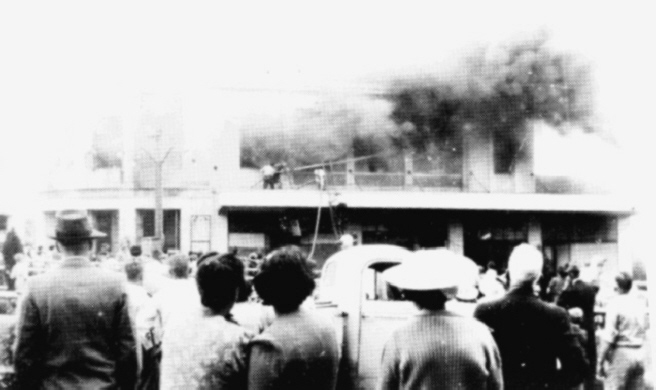
Local people watch the firemen battling the smoke and flames at the Maroochy Shire Hall, 26th April 1948. Many were still dressed in their Sunday best after having attended the Anzac Day parade and then Church services.
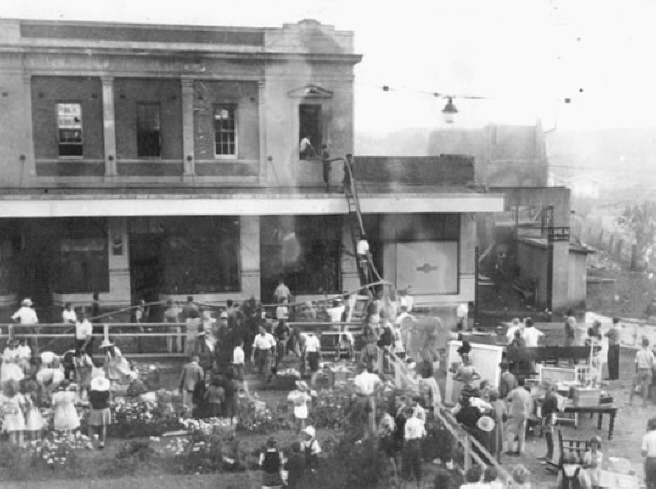
The fire damaged the Council Chambers and destroyed the Savoy cinema in the building (right of picture). The incident highlighted the need for better fire fighting services, and led to the setting up of the first Nambour-Yandina Fire Brigade Board, later to become the Maroochy Fire Brigade Board.
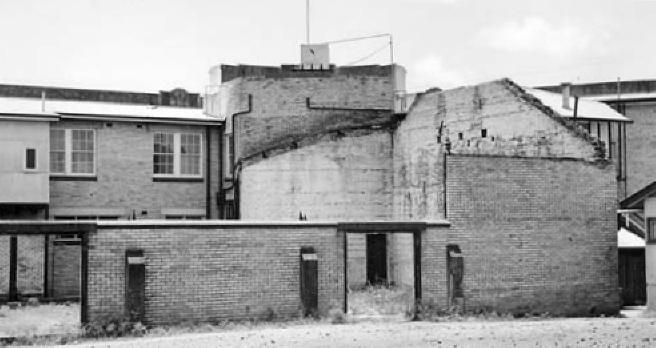
The rear view of the Maroochy Shire Hall in 1954, showing the remains of the auditorium that had operated as the Savoy Theatre. To the right of centre, the brick rear wall of the cinema is visible with its three main (and some smaller) projection ports. The motion picture projectors were housed in a fireproof room behind the ports, which protected them from the inferno.
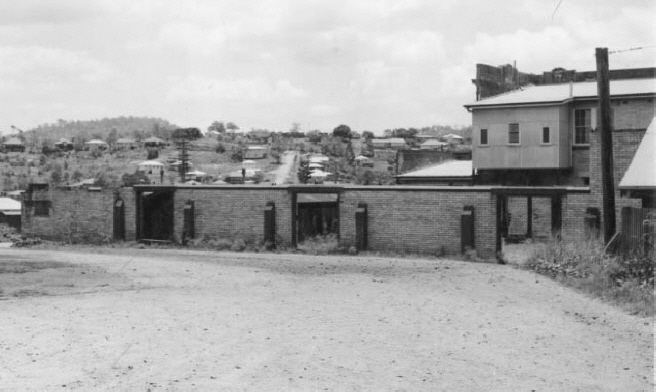
The lower side walls of the auditorium were made of brick, and survived the fire. Supporting buttresses and the spaces for the exit doors can still be seen in 1954, six years after the fire. The station end of the main Shire building is at right. Hospital Road can be seen in the centre background. After eleven years in this condition, a new Civic Hall was constructed on the site (below), and officially opened by the Governor of Queensland, Sir Henry Abel Smith on 6th August 1960.
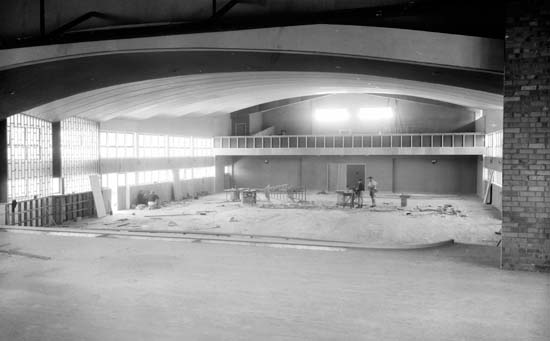
The new Civic Hall under construction in mid-1960, looking from the stage to the dress circle.
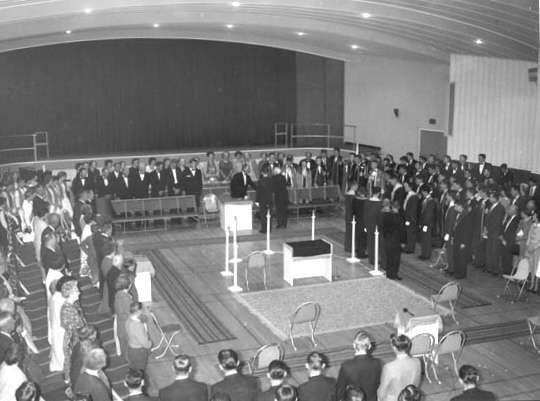
A large crowd attended this public function at the new Civic Hall on 14th
March 1962.
Photographs courtesy Sunshine Coast Libraries
THE AFTERMATH OF THE 1948 FIRE
During the early years of cinema, the movie film itself was on a nitrocellulose base, highly flammable and quite dangerous. Numerous cinema fires had been caused by the rapid ignition of the nitrate film by the hot arc lamps used in the projectors. The old wooden Nambour Town Hall had been lost in 1929 due to such an accident in its cinema. Since those days, Government regulations had stipulated that projection boxes be made fireproof to contain any conflagration, and appropriate exits be provided for the projectionists in the event of a fire.
In examining the ruins of the Savoy Theatre, it was obvious that the fire had started elsewhere in the auditorium, and the fireproof booth housing the two projectors had protected them from the fire. However, they had suffered from some damage by water, but were easily repairable. This was the only good news the Savoy Company had. They now had some equipment, but no cinema in which to use it. {30-4-1948, p.1}
The Company placed some notices in the Nambour Chronicle the Friday after the fire. Firstly, they thanked those people who had assisted during the emergency. Then, to keep faith with their patrons, they advised that they would screen their forthcoming programs at the Yandina Talkies on Wednesday and Friday nights, in addition to the normal Saturday night programs. Buses would run from the Maroochy Shire Hall to Yandina and return, so that Nambour people still had a cinema that they could visit. This was a temporary arrangement until they could convert their Diggers' Hall back into a cinema. This seems to indicate that the Savoy had some connection with the Yandina picture show, whose Manager was Mr J. Etheridge. The Yandina Talkies had been operating in the Yandina School of Arts every Saturday night for over three years before the Savoy fire, its first advertisement appearing on 5th January 1945. {5-1-1945, p.6} {30-4-1948, p.10} {25-6-1948, p.7}
The picture-showing licence for the Diggers'
Hall had been allowed to lapse, so the first thing the Savoy Company had to
do was to regain that licence. Accordingly, they wrote to the Picture
Theatres and Films Commission the day after the fire and made their request,
stating that the Diggers' Hall had a seating capacity of 650, and that they
intended to screen pictures every night, with an extra matinee on Saturdays.
The Commissioners replied that any objections to this proposal should be in
their hands on or before Monday, 17th May 1948. {7-5-1948,
p.4}
The Coolum locomotive passes the second Diggers'
Hall (built 1930) on the Queen Street corner as it trundles down Howard Street
The deputation was told that a picture licence
would be supported by the Council, if the Savoy Company made the following
improvements:
The Council also wrote to the Picture Theatres
and Films Commission, stating that they objected to the Commission's
granting of a picture licence to the Diggers' Hall, unless that Hall was
improved in accordance with the above 13 requirements. Some Councillors
quietly assured the Savoy Company that this was only a formality, and, as
soon as they complied, the picture licence for the Diggers' Hall would be
theirs. The Savoy Company
began work at once on the improvements, one of the requirements being a reduction in
seating capacity. In mid-June they ran this advertisement in the paper:
For
Sale, large quantity Canvas Theatre Seats. Apply Manager, Savoy Theatre,
Howard Street, Nambour. {28-5-1948, p.8}
{18-6-1948,
p.5}
The Savoy Company also asked the
Maroochy Council when the Shire Hall auditorium would be rebuilt. The answer
was, not soon, as the subject would need a lot of discussion. In fact, a
replacement Hall had to wait for over twelve years, not being finally
re-opened until August, 1960, and then burned down again in 1986. {28-5-1948, p.8}
************************************************************
Up at the Vogue Theatre, receiving permission from the Maroochy Shire
Council to screen pictures was one thing, but the gaining of an official
licence from the Picture Theatre and Films Commission was quite another. Mr McCorkell had had Council permission to show pictures
for nearly a year, but each time the Film Commissioners had heard his case,
the Savoy Company, represented by a barrister, claimed that the Savoy
Company was running at a loss, and a second cinema in Nambour was not
warranted. By mid-June 1948, neither the Vogue nor the Diggers' Hall (Savoy)
had a current licence to show pictures, so the patrons in Nambour had to
either endure a hiatus in their cinema-going, or catch the bus to
the Yandina School of Arts Talkies.
Mr McCorkell was supported by many people and
organisations in the town, particularly the R.S.S.A.I.L.A. and the Chamber
of Commerce, and the following letter to the editor of the Nambour
Chronicle printed on 11th June 1948 was typical of the town's sentiment.
The letter was obviously aimed at influencing the Commissioners, who were
scheduled to hold sittings at Nambour on 21st and 22nd June. It stated:
Sir, Evidence before the Films
Commission in regard to the Second Picture Licence is likely to be taken in
the near future. At a public protest meeting held in Nambour some time ago,
it was stated that the Commission had been informed by objectors to the
second licence application that the present picture business [the Savoy] was
losing ₤65 per annum. This appeared to be a
grand trump card for the refusal.
A
recent move by Nambour pictures monopolists
is in a different direction. They have apparently secured the support and
co-operation of various outside picture proprietors to help sustain their
objection. I am with other Nambourites in wondering why outsiders are
pushing the case of the Savoy Picture Co. This shows that they have very
flimsy arguments to keep out a second licence. In Bundaberg I observed that
there are four picture shows, and admission prices are 1/3, 1/11 and 2/7 --
8d. and 5d. cheaper than Nambour, and in addition, patrons have the choice
of programmes, whereas at Nambour there is none.
The
Vogue Theatre is ready for immediate occupation. No matter how good the
renovation may be at the Diggers' Hall, it cannot equal the Vogue for
comfort, safety and convenience. The danger at the Diggers' Hall is
imminent, more especially as the Council has ignored its own committee's
recommendations towards eliminating many of the dangers that are now
apparent. Yours etc., M. ERBACHER. {11-6-1948, p.5}
Sure enough, when the Picture Theatres and Films Commission
had its next sitting in Nambour on 21st and 22nd June,
the Savoy Company did enlist the help of 'outsiders' to reinforce their
opposition to the Vogue Theatre gaining a second licence. Among their supporters were Mr H. Anderson of the Embassy
Talkies (Palmwoods), Mr J. Etheridge of the Yandina Talkies and Mr Caldwell
representing the Motion Pictures Exhibitors' Association. Mr McCorkell
produced a number of local people who indicated their strong support for his
application. The hearing was adjourned to Brisbane for the final addresses
by counsels for Mr McCorkell and the Nambour Savoy Pictures Ltd. to be heard
the next day. At the conclusion of the hearing in Brisbane on 23rd June, the Commission
reserved its decision. {25-6-1948, p.7}
Although the Vogue remained unlicensed for
public screening of motion pictures, a loophole in the law permitted it to
show films to private groups or organisations, provided that there were no
admission charges. The mothballed film
projectors were fired up on the evening of Monday, 17th May 1948, to show
some Gospel films brought by the evangelists V. W. Hartin and A. N. Back. On Thursday, 15th July,
the Vogue was used to show a
series of films for the Queensland Cane Growers' Council, to which all cane
growers and others interested in the sugar industry were invited. Entry was
free, and the films were designed to show the latest innovative practices
being adopted for the growing of sugar cane. They illustrated "mechanical
cane harvesting, soil conservation, mechanical one-man farming, and various
industries in America, and were taken during an Overseas Delegation.".
{14-5-1948, p.7} {9-7-1948, p.4}
By the end of June the Savoy Company had
brought the Diggers' Hall into compliance with the 13-point fire-safety requirements.
The Council approved the Diggers' Hall as a picture-showing venue, and a
licence from the Films Commission was granted to replace that of the lost
Savoy Theatre. The following advertisement was placed in the Nambour Chronicle of 2nd
July 1948:
The Diggers' Hall was back to being a cinema
once again, as a reincarnation of the Savoy, and regular
advertisements for coming attractions appeared for the next five weeks. {2-7-1948, p.8}
As it was looking like Mr McCorkell was never
going to get his licence, and that the Savoy Company would continue its
cinema monopoly aided and abetted by the Films Commission, the Nambour
Sub-Branch of the R.S.S.A.I.L.A. called another
public
meeting to be held on 5th August, so show further support for a licence
to be given to the Vogue Theatre. {30-7-1948, p.10}
Suddenly, everything changed almost overnight,
which resulted in the above meeting being cancelled at the last minute. The
Nambour Chronicle ran the
story at
the top of page 1 of its issue of 6th August. Mr McCorkell had purchased the
Nambour Savoy Pictures Ltd., effective from 13th August, and now he owned the Diggers' Hall as well as
the Vogue Theatre. Apparently he had not been convinced by the Freeleagus's
claim to the Films Commission that their cinema had been losing money, as
quoted in Mr Erbacher's letter above, and had made them a successful offer.
This meant that Eric McCorkell, in buying the Savoy Company,
now had his long-hoped-for licence, but it was only usable for the Diggers' Hall,
and not transferable to the Vogue. {6-8-1948, p.1}
The Chronicle's next issues contained
two letters
from Mr McCorkell, which outlined his intentions for the Diggers' Hall and
the Vogue. He was profuse in his thanks to the local folk who had assisted
him in his long battle. A generous 'thank
you' to the people of Nambour from Messrs Christie and Dennis Freeleagus
and Mr R. Kelleway also appeared, expressing their appreciation for the
town's patronage in the past, and wishing Mr McCorkell every success in his
new venture. {13-8-1948, p.5,8} {3-9-1948, p.4}
A week after Mr McCorkell took over, he was
presenting his
first regular movie programs at the Diggers' Hall. Eschewing the 'Savoy' name he was now
entitled to use, he advertised his theatre as the 'Diggers' Hall Pictures.' He
presented his
films there
each week for six months until the Films Commission finally granted the Vogue Theatre
its licence to operate as a cinema. The
first screening
at the Vogue was on 9th
March 1949, three-and-a-half years after Mr McCorkell's first approach to
the Council, and eighteen months after the theatre had been completed.
Included in that first program was a short film, Sun Drenched, which
was the story of the pineapple industry. Mr McCorkell had photographed the
film himself in the Nambour district, and this was its first public
screening before being despatched overseas.
{4-3-1949, p.5} {11-3-1949, p.7}
With
the Vogue now operating as a cinema, Mr McCorkell encouraged people to hire
the Diggers' Hall again for dances, balls, plays, music recitals and
concerts, but after six months, cinema patronage had
increased to the extent that he began to use the Diggers' Hall on Saturday
nights as a second cinema, showing the same programs as the Vogue. The first
of these screenings was on 24th September. The
people of Nambour, having lost one cinema monopoly under Michael Gray and
Edgar Wells, and a second one under the Freeleagus
brothers, now had a third one under Eric McCorkell.
{28-9-1945, p.1} {29-8-1947, p.7}
{27-8-1948, p.10}
{6-3-1949, p.8} {23-9-1949, p.10}
Bookings for live entertainment in the
Diggers' Hall were picking up, so its use as a cinema only lasted for four
months until the end of January, 1950. The next month, Lester's Follies
proved to be a popular variety show held there, and it was followed by
numerous and varied functions. One of the most peculiar was an auction of
'large stocks of CONTRABAND GOODS', held over three days at the end of
February. {24-2-1950, p.4}
{17-2-1950, p.4}
The Nambour Eisteddfod in 1950 had to be
cancelled, as the town had no venue that was large enough. The Eisteddfod's
Committee could no longer use the Vogue Theatre, due to restrictions imposed
by the Picture Theatres and Films Commission on the cinema's use for other
purposes. The Diggers' Hall was considered to have unsuitable seating and to
be too small , and the Show Pavilion did not have enough seats. The
Council was thinking of rebuilding the Maroochy Shire Hall's burned
auditorium, but they were considering a hall with a capacity of about 400,
which the Chronicle said was woefully inadequate for a growing town,
and typical of the Council's lack of a progressive outlook. These wise words
fell on deaf ears, and the Council continued to procrastinate on building a
replacement civic auditorium for another decade.
{16-9-1949, p.7}
Mr McCorkell continued to be a popular figure
in the town, and on 26th May 1949 he was elected as a Councillor of the
Maroochy Shire, along with two other ex-Diggers, Jack Broughton and 'Dusty'
Rhodes, the trio being referred to as the 'Three Musketeers'. All three were
elected with handsome majorities. By 1953 Mr McCorkell had sold the Vogue
Theatre to the Venardos Brothers, newly arrived in Nambour, but kept the Diggers' Hall. In 1955 he
became Deputy Shire
Chairman.
{3-6-1949, p.4,7} {24-2-1950, p.4} {27-1-1950, p.10} {26-6-1953, p.9}
{20-5-1955, p.8}
Debutantes and their
partners at a Ball at the Diggers' Hall in 1953.
The Vogue, built out of second-hand
materials, served its purpose for a decade, but the Venardos Brothers
revealed plans to replace
it with a more
centrally located cinema costing ₤60 000 in 1957.
The new Vogue eventually cost ₤70
000, and was officially opened for business on 19th February 1958 by Mr
David Low M.L.A., Chairman of the Maroochy Shire Council. This was "one of
the brightest occasions in Nambour for years", and was attended by an
audience of over 1000 'first nighters'. The new cinema was described as a
"comfortable, modern building", and was designed and constructed by local
firms. This
new Vogue Theatre
was still showing films into the 1980s, and the famous opera star June
Bronhill was an honoured guest at a function there in that decade, arriving
in Des Scanlan's Rolls Royce. The cinema soon closed down after that, but the
vacant building still
exists today in Currie Street,
adjoining the Royal
George Hotel.
{5-4-1957, p.6}
{29-11-1957, p.3} {21-2-1958, p.5}
The building that once
housed the second Vogue Cinema, was later used by Dimmeys budget store. Since this picture was
taken in 2009, the building has been re-roofed and the exterior walls
covered with aluminium cladding, which covers the louvre windows. Dimmeys
closed their store in 2019, and at the time of writing the building is
vacant.
To be continued
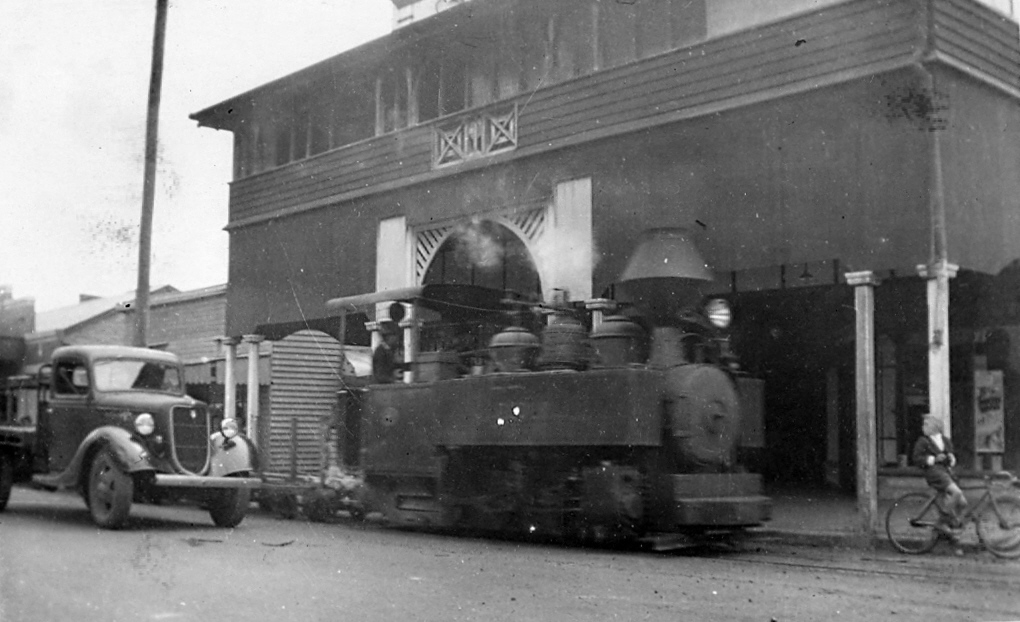
1. A fire-resistant wall to be placed along the eastern
side, made of brick and at least 14 inches thick;
2. Sufficient exits be established to permit of the
emptying of the building within five minutes, following an alarm;
3. A 4 feet wide door be placed at the rear of the hall,
with suitable steps leading down to ground level;
4. A small escape door from the projection room or box to
be provided for the operators, not less than 2 feet 6 inches in width and
not less than 4 feet in height and to open outwards;
5. A stout rope be tied within the room or box, with one
loose end, to be provided as a means of assistance for operators to lower
themselves from the room or box (such room or box being only 8 feet above
floor level);
6. The provision of two iron escape ladders from balcony
to ground, the lower 6 feet being hinged, turned upwards and tied loosely
(height of balcony 16 feet from floor to ground);
7. Palisading to be removed from between posts on balcony
and suitable guards erected;
8. The roof to be made waterproof and all broken spouting
to be renewed;
9. Fire-extinguishing appliances to be procured and housed
to the satisfaction of the Council;
10. The seating capacity be limited to 481 persons, thus maintaining
two 4 feet aisles the full length of the seats - the front row of seats to
be 6 feet 6 inches from the front of the stage and the back row of centre
seats to be kept 10 feet forward in the body of the hall from the main
entrance;
11. Adequate toilet accommodation as required by Council regulations
be supplied:
12. An extra light be fitted on the exterior of the north wall to
illuminate the yard;
13. All matters pertaining to Council By-law 404, dealing with public safety, be complied with.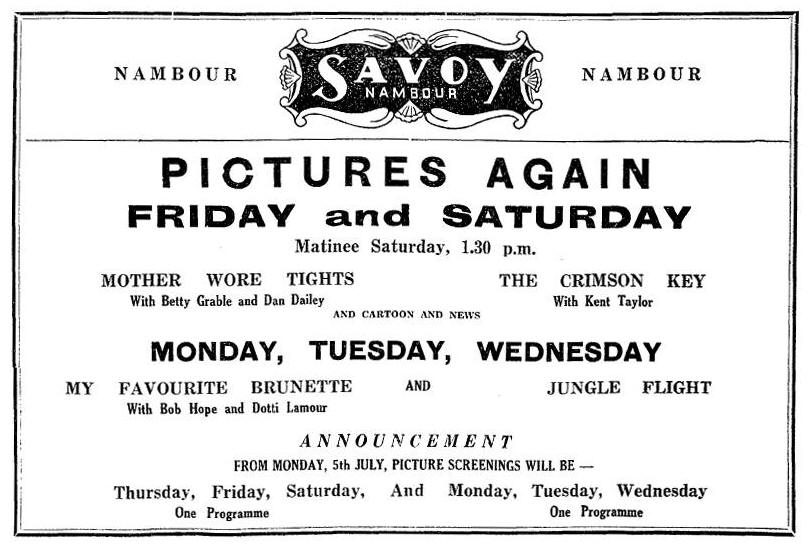

Photograph
courtesy Sunshine Coast Libraries